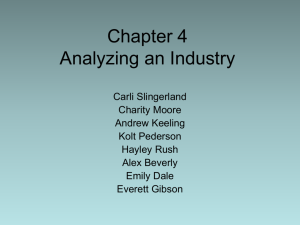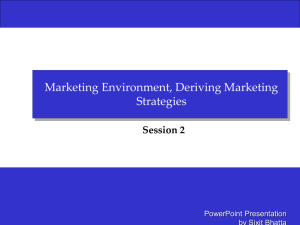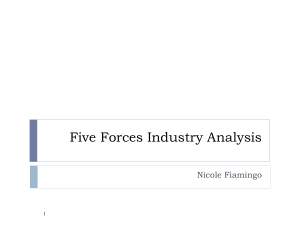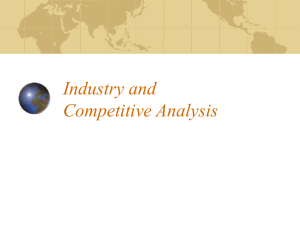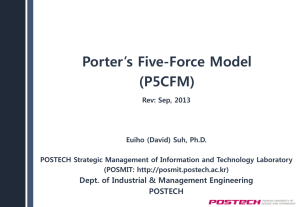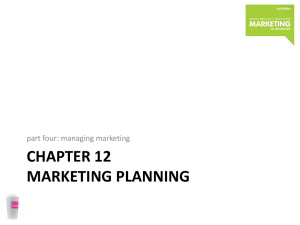External Environmental Analysis
advertisement
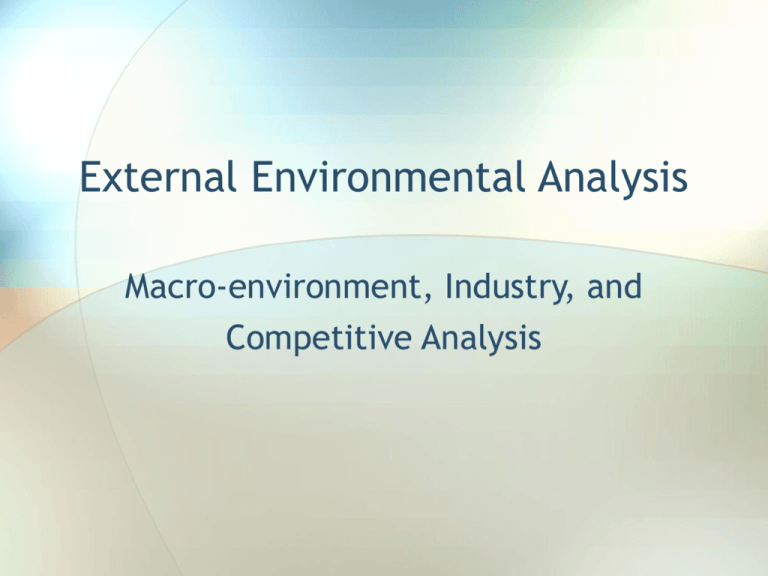
External Environmental Analysis Macro-environment, Industry, and Competitive Analysis Macro-environmental Forces General Environment • Dimensions in the broader society that influence and industry and the firms within it − Economic − Sociocultural − Global − Technological − Political/legal − Demographic Industry Environment • Set of factors directly influencing a firm and its competitive actions and competitive responses Competitor Environment • All of the companies that the firm competes against. Analysis of the External Environments • General environment − Focused on the future • Industry environment − Focused on factors and conditions influencing a firm’s profitability within an industry • Competitor environment − Focused on predicting the dynamics of competitors’ actions, responses and intentions Opportunities and Threats • Opportunity − A condition in the general environment that if exploited, helps a company achieve strategic competitiveness • Threat − A condition in the general environment that may hinder a company’s efforts to achieve strategic competitiveness External Environmental Analysis • A continuous process which includes − Scanning for early signals of potential changes and trends in the general environment − Monitoring changes to see if a trend emerges from among those spotted by scanning − Forecasting projections of outcomes based on monitored changes and trends − Assessing the timing and significance of changes and trends on the strategic management of the firm General Environment •The Economic Segment •The Socio-cultural Segment −Inflation rates −Women in the workplace −Interest rates −Workforce diversity −Trade deficits or surpluses −Budget deficits or surpluses −Attitudes about quality of work-life −Personal savings rate −Concerns about environment −Business savings rates −Shifts in work and career preferences −Gross domestic product −Shifts in product and service preferences General Environment •The Global Segment •The Technological Segment − Important political events −Product innovations − Critical global markets −Applications of knowledge − Newly industrialized countries and emerging markets −Focus of private and government-supported R&D expenditures − Different cultural and institutional attributes −New communication technologies General Environment •The Political/Legal Segment •The Demographic Segment −Antitrust laws −Population size −Taxation laws −Age structure −Deregulation philosophies −Geographic distribution −Labor training laws −Ethnic mix −Educational philosophies and policies −Income distribution Industry Environment • Industry Defined − A group of firms producing products that are close substitutes • Firms that influence one another • Includes a rich mix of competitive strategies that companies use in pursuing strategic competitiveness and above-average returns The Five Forces of Competition Model Barriers to entry • A barrier to entry is any factor that − Increases the costs born by potential entrants (relative to incumbents), after they enter the market − Decreases the market share potential entrants might receive upon entering the industry − Other factors • Trade restrictions (tariffs, quotas, voluntary export restraints, infant industry protection, embargoes) • Government regulation of industries • Industry certification boards (CPAs, Actuaries) Barriers that Increase Cost • Capital markets (requires inefficient capital markets) • Proprietary technology (patents, copyrights, trade secrets) • Know-how (knowledge, routines, capabilities) • Access to raw materials (unanticipated value) • Geographic locations • Economies of scale • Learning by doing Barriers Limiting Market Share • Product differentiation • Advertising/Brand image • Access to distribution • Customer switching costs • Expected retaliation Barriers to Entry o Economies of Scale o Marginal improvements in efficiency that a firm experiences as it incrementally increases its size •Product differentiation •Capital Requirements −Unique products −Physical facilities −Customer loyalty −Inventories −Products at competitive prices −Marketing activities •Switching Costs −One-time costs customers incur when they buy from a different supplier −New equipment −Retraining employees −Psychic costs of ending a relationship −Availability of capital •Access to Distribution Channels −Stocking or shelf space −Price breaks −Cooperative advertising allowances Barriers to Entry (cont’d) •Cost Disadvantages Independent of Scale −Proprietary product technology −Favorable access to raw materials −Desirable locations •Government policy −Licensing and permit requirements −Deregulation of industries •Expected retaliation −Responses by existing competitors may depend on a firm’s present stake in the industry (available business options) Power of Suppliers • Suppliers deliver inputs such as − Labor − Management − Technology − Materials • Suppliers influence our costs through the strength of their bargaining power Bargaining Power of Suppliers • Supplier power increases when: − Suppliers are large and few in number − Suitable substitute products are not available − Individual buyers are not large customers of suppliers and there are many of them − Suppliers’ goods are critical to buyers’ marketplace success − Suppliers’ products create high switching costs. − Suppliers pose a threat to integrate forward into buyers’ industry Buyer/Customer Power & Preferences • Buyers/Customers influence our prices through: − Their ability to exercise bargaining power over us – industrial markets with few buyers − The strength of their preferences – consumer sovereignty and elasticity of demand Bargaining Power of Buyers/Customers • Buyer power increase when: − Buyers are large and few in number − Buyers purchase a large portion of an industry’s total output − Buyers’ purchases are a significant portion of a supplier’s annual revenues − Buyers can switch to another product without incurring high switching costs − Buyers pose threat to integrate backward into the sellers’ industry Threat of Substitute Products • Substitutes are defined by product function, not by product form • The threat of substitute products increases when: − Buyers face few switching costs − The substitute product’s price is lower − Substitute product’s quality and performance are equal to or greater than the existing product − Consumer tastes and preferences • Differentiated industry products that are valued by customers reduce this threat Intensity of Rivalry/Threat of Rivalry • Rivalry is the threat of established firms competing away their economic profits − Price competition − Frequent introduction of new products − Intense advertising campaigns − Rapid competitive response Intensity of Rivalry Among Competitors • Industry rivalry increases when: − There are numerous or equally balanced competitors − Industry growth slows or declines − There are high fixed costs or high storage costs − There is a lack of differentiation opportunities or low switching costs − When the strategic stakes are high − When high exit barriers prevent competitors from leaving the industry Interpreting Industry Analyses Suppliers and buyers have strong positions Low entry barriers Strong threats from substitute products Intense rivalry among competitors Unattractive Industry Low profit potential Interpreting Industry Analyses High entry barriers Suppliers and buyers have weak positions Few threats from substitute products Moderate rivalry among competitors Attractive Industry High profit potential Competitor Analysis • Competitor Intelligence − The ethical gathering of needed information and data that provides insight into: • A competitor’s direction (future objectives) • A competitor’s capabilities and intentions (current strategy) • A competitor’s beliefs about the industry (its assumptions) • A competitor’s capabilities Competitor Analysis Components
